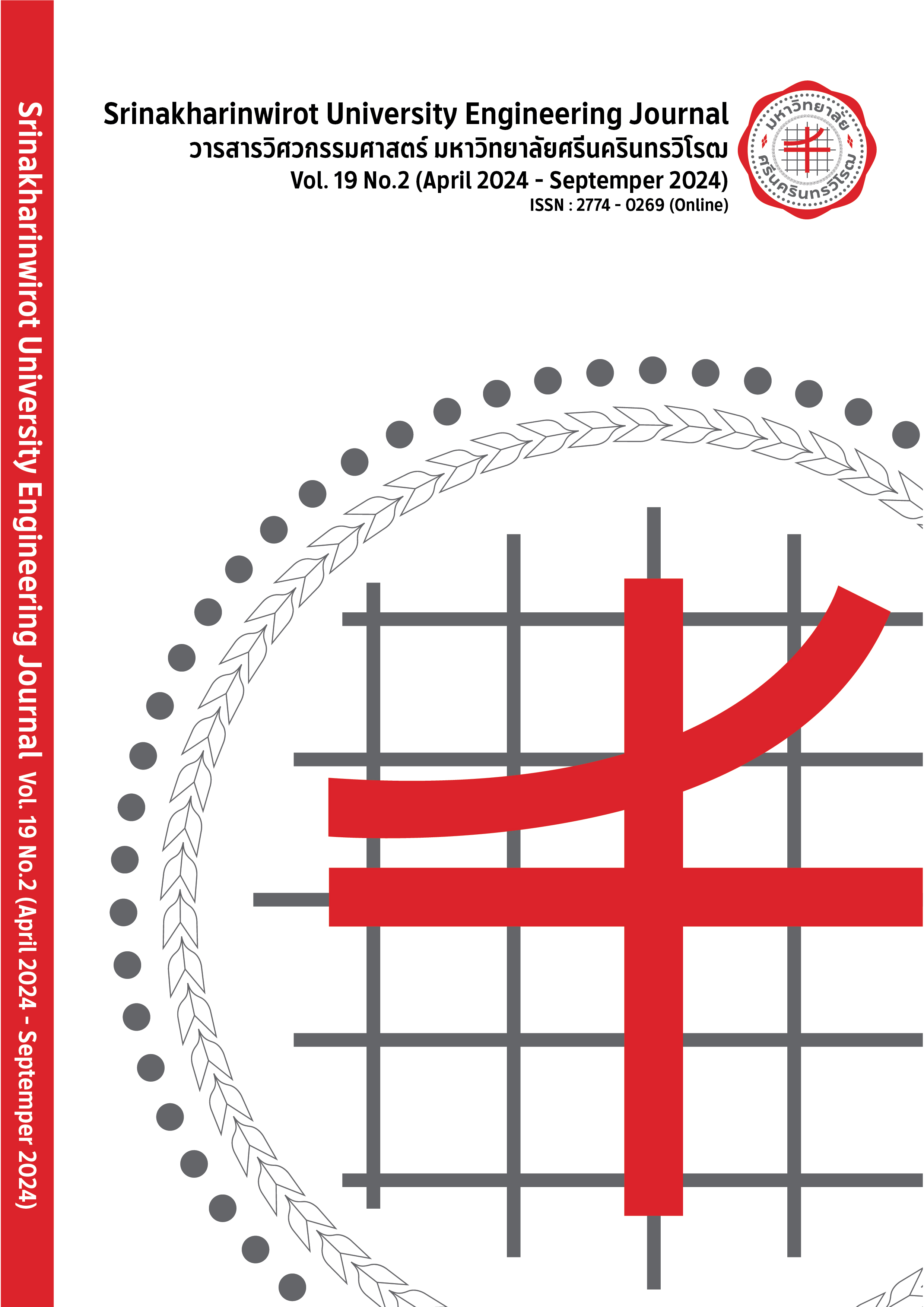Conversion of Natural Rubber Product to Bio-Crude Oil By Hydrothermal Liquefaction Process
Main Article Content
Abstract
This research investigates the conversion yield of natural rubber product such as raw rubber sheets, cup lumps, and Para rubber latex to bio-crude oil by hydrothermal liquefaction process. The reaction temperatures are in the ranges of 350 °C and 375 °C. The materials are dissolved in water at H2O/NR mass ratios of 2:1, 3:1, and 4:1. The reaction time was 60 minutes. Results show that the highest yields of bio-crude oil is 71.40% by using raw rubber sheets as raw material, while the bio-crude oil yield from using cup lumps, and Para rubber latex are 70.03% and 22.47% respectively. The Fourier Transform Infrared Spectrometer (FT-IR) analysis shows peak absorbance at 2,920 cm–1, indicating the intensity of the absorbance of the alkane functional group (C-H) which indicates fuel oil property. This study shows the technical possibility of producing bio-crude oil from natural rubber in Thailand by-using the hydrothermal liquefaction process. This might be the alternative energy in the future and support the beneficial of using Para rubber as well.
Article Details

This work is licensed under a Creative Commons Attribution-NonCommercial-NoDerivatives 4.0 International License.
Copyright belongs to Srinakharinwirot University Engineering Journal
References
M. F. Demirbas and M. Balat, “Recent advances on the production and utilization trends of bio-fuels: a global perspective,” Energy Conversion and Management, vol. 47, no. 15–16, pp. 2371–2381, 2006.
S. Prasad, V. Venkatramanan, S. Kumar and K. R. Sheetal, “Biofuels: a clean technology for environment management,” Sustainable Green Technologies for Environmental Management, pp. 219–240, 2019.
B. Şahin, S. Aslan, Z. Ceylan and S. Yolcular Karaoglu, "Sustainability and socioeconomic impacts of bioenergy," Bioenergy Studies, Black Sea Agricultural Research Institute, 2021.
R.A. Vigouroux, "Pyrolysis of biomass: rapid pyrolysis at high temperature: slow pyrolysis for active carbon preparation," 2001.
M. Ahmad, M.A. Khan, M. Zafar, M. and S. Sultana, "Biodiesel from non edible oil seeds: a renewable source of bioenergy," in Economic Effects of Biofuel Production, 2011.
M. Balat, “Potential alternatives to edible oils for biodiesel production – a review of current work,” Energy Conversion and Management, vol. 52, no. 2, pp. 1479–1492, 2011.
A. Krutof and K. Hawboldt, “Blends of pyrolysis oil, petroleum, and other bio-based fuels: a review,” Renewable and Sustainable Energy Reviews, vol. 59, pp. 406–419, 2016.
H. Li, J. Hu, Z. Zhang, H. Wang, F. Ping, C. Zheng, H. Zhang, Q. He, “Insight into the effect of hydrogenation on efficiency of hydrothermal liquefaction and physico-chemical properties of biocrude oil,” Bioresource Technology, vol. 163, pp. 143–151, 2014.
F. Li, S. C. Srivatsa and S. Bhattacharya, “A review on catalytic pyrolysis of microalgae to high-quality bio-oil with low oxygeneous and nitrogenous compounds,” Renewable and Sustainable Energy Reviews, vol. 108, pp. 481–497, 2019.
N. Ahmad, F. Abnisa and W. M. A. Wan Daud, “Liquefaction of natural rubber to liquid fuels via hydrous pyrolysis,” Fuel, vol. 218, pp. 227–235, 2018.
S.W. Murni and T.M. Setyoningrum, "The effect of pyrolysis temperature on charcoal briquettes from biomass waste," LPPM UPN “Veteran” Yogyakarta Conference Series Proceeding on Engineering and Science Series (ESS), vol.1, no. 1, pp.453-460, 2020.
B. Sugebo, Z. Demrew, S. Feleke and M. Biazen, “Evaluation and characterization of rubber seed oil for biodiesel production,” Biomass Conversion and Biorefinery, 2021.
H. Veny, M.A.A.A. Rani, F.H.A. Hamid, N. Aziz, R. A. Sazali and S.S. Idris, “Enzymatic transesterification of rubber seed oil using Immobilized pseudomonas cepacia lipase,” Journal of Physics: Conference Series, vol. 2266, no. 1, p. 012013, 2022.
N. Ahmad, S. A. S. Dayana, F. Abnisa and W. A. W. D. Mohd, “Natural rubber, a potential alternative source for the synthesis of renewable fuels via hydrous pyrolysis,” IOP Conference Series: Materials Science and Engineering, vol. 334, p. 012004, 2018.
T. Kan, V. Strezov and T. Evans, “Fuel production from pyrolysis of natural and synthetic rubbers,” Fuel, vol. 191, pp. 403–410, Mar. 2017.
D. Spanò, F. Pintus, C. Mascia, M. A. Scorciapino, M. Casu, G. Floris and R. Medda, “Extraction and characterization of a natural rubber from euphorbia characias latex,” Biopolymers, vol. 97, no. 8, pp. 589–594, 2012.
C. Bottier, “Biochemical composition of hevea brasiliensis latex: a focus on the protein, lipid, carbohydrate and mineral contents,” in Latex, Laticifers and Their Molecular Components - From Functions to Possible Applications, R. Nawrot, Ed., Elsevier, 2020, pp. 201–237.
D. T. Chen, C. A. Perman, M. E. Riechert and J. Hoven, “Depolymerization of tire and natural rubber using supercritical fluids,” Journal of Hazardous Materials, vol. 44, no. 1, pp. 53–60, Nov. 1995.
M. A. Hazrat, M. G. Rasul and M. M. K. Khan, “Lubricity improvement of the ultra-low sulfur diesel fuel with the biodiesel,” Energy Procedia, vol. 75, pp. 111–117, Aug. 2015.
N. Ahmad, F. Abnisa and W. M. A. W. Daud, “Potential use of natural rubber to produce liquid fuels using hydrous pyrolysis – a review,” RSC Advances, vol. 6, no. 73, pp. 68906–68921, 2016.

